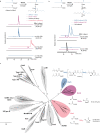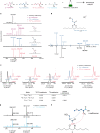Biosynthesis of the Unusual Carbon Skeleton of Nocuolin A
- PMID: 36044983
- PMCID: PMC9486936
- DOI: 10.1021/acschembio.2c00464
Biosynthesis of the Unusual Carbon Skeleton of Nocuolin A
Abstract
Nocuolin A is a cytotoxic cyanobacterial metabolite that is proposed to be produced by enzymes of the noc biosynthetic gene cluster. Nocuolin A features a 1,2,3-oxadiazine moiety, a structural feature unique among natural products and, so far, inaccessible through organic synthesis, suggesting that novel enzymatic chemistry might be involved in its biosynthesis. This heterocycle is substituted with two alkyl chains and a 3-hydroxypropanoyl moiety. We report here our efforts to elucidate the origin of the carbon skeleton of nocuolin A. Supplementation of cyanobacterial cultures with stable isotope-labeled fatty acids revealed that the central C13 chain is assembled from two medium-chain fatty acids, hexanoic and octanoic acids. Using biochemical assays, we show that a fatty acyl-AMP ligase, NocH, activates both fatty acids as acyl adenylates, which are loaded onto an acyl carrier protein domain and undergo a nondecarboxylative Claisen condensation catalyzed by the ketosynthase NocG. This enzyme is part of a phylogenetically well-defined clade within similar genomic contexts. NocG presents a unique combination of characteristics found in other ketosynthases, namely in terms of substrate specificity and reactivity. Further supplementation experiments indicate that the 3-hydroxypropanoyl moiety of 1 originates from methionine, through an as-yet-uncharacterized mechanism. This work provides ample biochemical evidence connecting the putative noc biosynthetic gene cluster to nocuolin A and identifies the origin of all its carbon atoms, setting the stage for elucidation of its unusual biosynthetic chemistry.
Conflict of interest statement
The authors declare no competing financial interest.
Figures





Similar articles
-
The Cyanobacterial Oxadiazine Nocuolin A Shows Broad-Spectrum Toxicity Against Protozoans and the Nematode C. elegans.Microb Ecol. 2025 Mar 4;88(1):9. doi: 10.1007/s00248-025-02507-2. Microb Ecol. 2025. PMID: 40035794 Free PMC article.
-
Terminal Olefin Profiles and Phylogenetic Analyses of Olefin Synthases of Diverse Cyanobacterial Species.Appl Environ Microbiol. 2018 Jun 18;84(13):e00425-18. doi: 10.1128/AEM.00425-18. Print 2018 Jul 1. Appl Environ Microbiol. 2018. PMID: 29728380 Free PMC article.
-
Antifouling activity and ecotoxicological profile of the cyanobacterial oxadiazine nocuolin A.Chemosphere. 2024 Oct;365:143318. doi: 10.1016/j.chemosphere.2024.143318. Epub 2024 Sep 11. Chemosphere. 2024. PMID: 39271082
-
Fatty acyl-AMP ligases and polyketide synthases are unique enzymes of lipid biosynthetic machinery in Mycobacterium tuberculosis.Tuberculosis (Edinb). 2011 Sep;91(5):448-55. doi: 10.1016/j.tube.2011.04.006. Epub 2011 May 20. Tuberculosis (Edinb). 2011. PMID: 21601529 Review.
-
Enzymology of standalone elongating ketosynthases.Chem Sci. 2022 Mar 9;13(15):4225-4238. doi: 10.1039/d1sc07256k. eCollection 2022 Apr 13. Chem Sci. 2022. PMID: 35509474 Free PMC article. Review.
Cited by
-
Uncovering the substrate of olefin synthase loading domains in cyanobacteria Picosynechococcus sp. strain PCC 7002.RSC Chem Biol. 2025 Jan 14;6(2):307-316. doi: 10.1039/d4cb00234b. eCollection 2025 Feb 5. RSC Chem Biol. 2025. PMID: 39817101 Free PMC article.
-
Incorporation, fate, and turnover of free fatty acids in cyanobacteria.FEMS Microbiol Rev. 2023 Mar 10;47(2):fuad015. doi: 10.1093/femsre/fuad015. FEMS Microbiol Rev. 2023. PMID: 37061785 Free PMC article. Review.
-
The Cyanobacterial Oxadiazine Nocuolin A Shows Broad-Spectrum Toxicity Against Protozoans and the Nematode C. elegans.Microb Ecol. 2025 Mar 4;88(1):9. doi: 10.1007/s00248-025-02507-2. Microb Ecol. 2025. PMID: 40035794 Free PMC article.
-
Biochemical Studies of a Cyanobacterial Halogenase Support the Involvement of a Dimetal Cofactor.Biochemistry. 2025 May 20;64(10):2173-2180. doi: 10.1021/acs.biochem.4c00720. Epub 2025 Apr 29. Biochemistry. 2025. PMID: 40300765 Free PMC article.
-
Fatty acyl-AMP ligases in bacterial natural product biosynthesis.Nat Prod Rep. 2025 Apr 16;42(4):739-753. doi: 10.1039/d4np00073k. Nat Prod Rep. 2025. PMID: 39968878 Free PMC article. Review.
References
-
- Burja A. M.; Banaigs B.; Abou-Mansour E.; Burgess J. G.; Wright P. C. Marine cyanobacteria - a prolific source of natural products. Tetrahedron 2001, 57, 9347–9377. 10.1016/S0040-4020(01)00931-0. - DOI
-
- Tidgewell K.; Clark B. R.; Gerwick W. H., The Natural Products Chemistry of Cyanobacteria. Comprehensive Natural Products Ii: Chemistry and Biology, Vol 2: Natural Products Structural Diversity-Ii: Secondary Metabolites: Sources, Structures and Chemical Biology, 2010; pp 141–188.
Grants and funding
LinkOut - more resources
Full Text Sources

